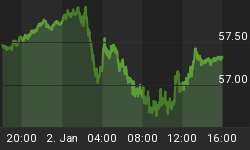In spite of the overwhelmingly supportive data - details in the next section - the bond market sold off last week and feels like it is fixin' to break down even further through the 4.25% support on the 10 year US Treasury note. The market action is worrisome and I believe we are at the crossroads here with the Fed rate decision setting the tone going forward. While there are a lot of analysts that are way smarter than I am doing all sorts of guesswork (forecasts?) about how the Fed will act on Tuesday, I would like to focus on a couple of aspects that I figure that should be considered at this junction. First of all, with regard to whether the Fed will raise the Funds rate another 25 basis points on or not, my guess is that they will, because that is what the Fed Funds futures are telling us. The Fed Funds futures have an excellent record in forecasting short-term Fed actions, so that is good enough for me. How the Fed will change its outlook is much more difficult to forecast, so rather than taking a wild guess at what they are going to say, I think it is more worthwhile to concentrate on the implications of the various outcomes. After a slow start, the Bush Administration is throwing everything, including the kitchen sink, at the Katrina recovery effort. The tab keeps growing; presently the bailout package looks to be around $200 billion. So the fiscal spigot is wide open. On the other hand, we had Master Al on tape just a couple of short weeks ago discussing targeting asset prices in order to keep inflation in check. Further to that, last week's reports indicated that consumer confidence is at is lowest level in a dozen years. That is lower than during 9/11 and any point in the stock market crash. Just as a reminder, the consumer drives 70% of the economy. So after raising 25 basis points on Tuesday just for good measure, what are the good folks at the Fed to do??? Should they join the recovery effort, stop tightening and enhance liquidity while ignoring rising energy costs and asset prices, or should they continue to raise rates as a means of targeting asset prices, while ignoring both the Katrina relief effort and the crashing consumer confidence. There is no easy answer, but we will get more clues on the Fed's course in the press statement that will be released after the FOMC meeting.
NOTEWORTHY: The economic data was weak last week. The consumer is losing confidence; the ABC Weekly Consumer Confidence poll has sunk from -7 to -20 in the past 4 weeks, while the University of Michigan Consumer Confidence survey skidded to 76.9, its lowest reading in 13 years. Inflation data continues to come in below expectations. Industrial Production and Capacity Utilization were flat. The Canadian economy is in the process of slowing as well. The upcoming week will be all about the Fed. The rest of the data will be minor.
INFLUENCES: The latest Treasury market surveys are still predominantly bearish. The 'smart money' commercials have decreased their long positions in the 10 year note futures from 158k to 125k this past week. This number is slightly positive for bonds. Seasonals are quite positive right through to the end of September. On the technical front, support at 4.25% looks rather feeble right now.
RATES: US Long Bond futures closed at 114-24, down close to $2 this past week, while the yield on the US 10-year note increased 15 basis points to 4.27%. The Canada - US 10 year spread was 5 wider at -35 basis points. The belly of the Canadian curve underperformed the wings by 1 basis point last week. Selling Canada 3.25% 12/2006 and Canada 5.75% 6/2033 to buy Canada 5.25% 6/2012 was at pick-up of 27 basis points. Assuming an unchanged curve, considering a 3-month time horizon, the total return (including roll-down) for the Canada bonds maturing in 2013 are the best value on the curve. In the long end, the Canada 8% bonds maturing on June 1, 2023 continue to be the cheapest issue on a relative basis. As mentioned above, the market is at the crossroads right now, if the Fed wavers from its tightening path, the long end will be highly vulnerable.
CORPORATES: Canadian Corporate bond spreads were stable last week. Long TransCanada Pipeline bonds were in 1 bp to 116, while long Ontario bonds were out 1 bp to 47. A starter short in TRAPs was recommended at 102 in February 2004. Shorter maturity, quality corporates should be favoured over lower rated issues as I believe corporate spreads will continue to be under pressure. Any credit that is connected with the consumer and discretionary spending should be avoided. We advised to sell 10 year Canadian Bank sub-debt at a spread of 58 bps over the 10 year Canada bond a few weeks ago. This spread closed at 55 basis points on Friday - unchanged on the week.
BOTTOM LINE: The bond market is not trading well. While the fundamentals are supportive, the market action was horrid last week. We closed the week near the 4.25% support on the 10 year Treasury Note yield. If the Fed signals an end to the tightening cycle on Tuesday, that will be negative for the long end of the yield curve and it will cause the yield curve to become steeper. On the other hand, if the Fed indicates that it plans to continue raising rates that should be supportive for the longer maturities and cause the yield curve to resume its flattening bias. The sell Canada 10 year bonds to buy US 10 year notes at 46 bps or better trade is still pending, we will not chase it at this point. An overweight position in the belly of the curve is still recommended for Canadian accounts. Short exposure for the corporate sector is advised.
















